This was published 4 years ago
Winter puma spotting in Torres del Paine National Park, Patagonia, Chile
By Belinda Jackson
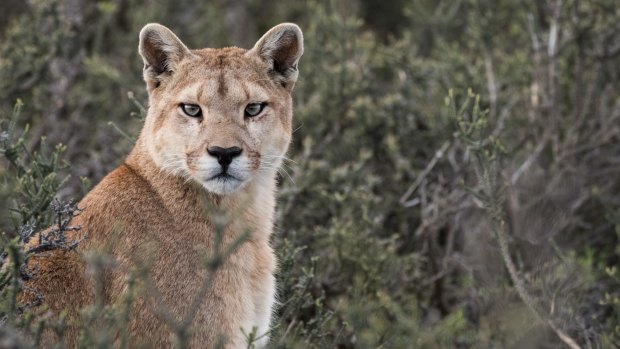
The largest of this mountain lion species, Patagonian pumas can reach 2.8 metres in length.
To fly over Chilean Patagonia in winter is an exercise in fortitude. Towering rocky peaks rear into stark skies, their long, jagged fingers seemingly reaching to snatch our aircraft. There are no towns and few roads wend between the expanse of snowy plains studded with glacial lakes. This is a landscape that demands focus. It's heroic, epic, and too magnificent to capture in one picture frame. But, of course, we try.
A decade ago, on my first visit to Patagonia and the Torres del Paine National Park, its tourist season extended through the summer only, from November until February, as hikers walked the five-day "W trek" or the longer "O trail" around the Paine massif.
Now, the action heats up in September, and pushes out till autumnal May. To call wintery July the off season is an understatement, and in an edgy marketing move, winter in Torres del Paine is being billed as the "secret season". But the secret remains – why would anyone go?
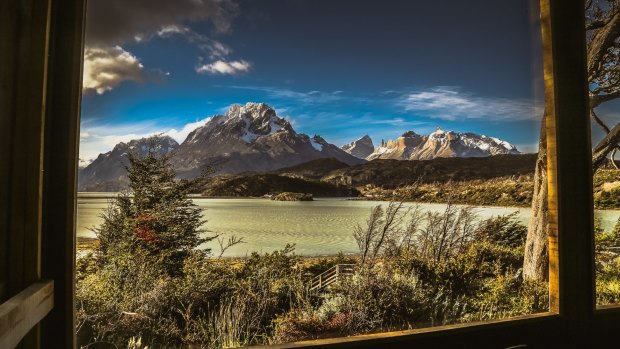
The view from the four-star Hotel Lago Grey.
We've come for the pumas.
PUFFER JACKET CENTRAL
"Patagonia's going to be all for you," says my Chilean guide a week earlier, as we ride our ponies through the Atacama Desert, 4000 kilometres north of Torres del Paine. Basking in the winter sun in the country's extreme north, he prepares me for the darkness, the plunging temperatures and for the sheer inaccessibility of the frozen south.
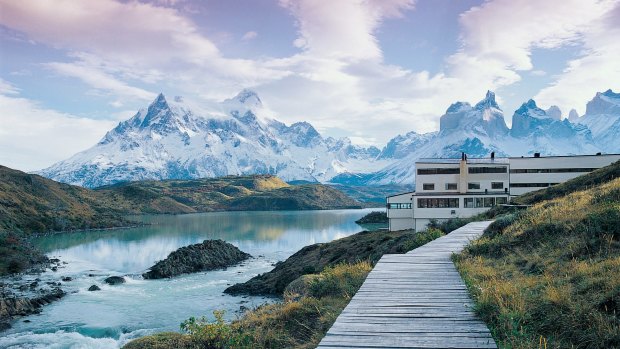
Most of the park's lodges and camps are closed in winter; the five-star Explora Lodge has always been the exception.
While he's talking, I'm privately calculating how many pairs of thermal leggings I can fit under my hiking pants. The average temperature, after all, is 3 degrees, its provinces bear such names as Ultima Esperanza (last hope) and the maps are waterproof.
There are a few logistics to consider when visiting in winter: for starters, the little Puerto Natales airport – the closest to Torres del Paine – closes in March. There is talk it will open year-round, but for now its closure necessitates a five-hour drive from the region's capital, Punta Arenas. Our icy path is lined with lichen forests and semi-frozen lagoons which are populated by neon-pink flamingos that wouldn't look out of place on a postcard from Miami. Most of the park's lodges and camps are closed; the five-star Explora Lodge has always been the exception, joined recently by the four-star Hotel Lago Grey.
Stretching out in Lago Grey's hotel's dining room after an extraordinarily Chilean dinner of guanaco empanadas and ceviche of Patagonian salmon, our puma-spotting group of two plus our guide Rodrigo, survey our fellow adventurers. It's puffer-jacket central, and though no one's mingling there's a sense of camaraderie among the group. In summer, this well-priced hotel is overflowing.
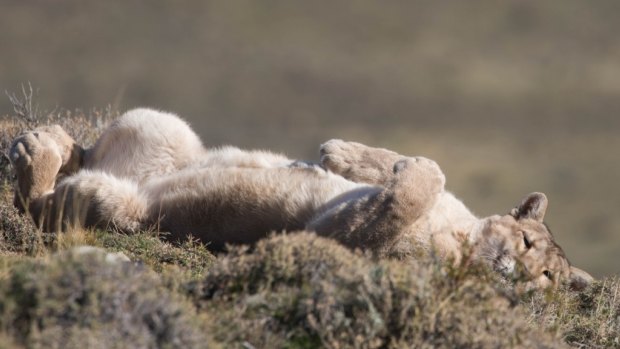
The Chilean government hauled a protective cloak over its pumas in the 1970s, but they've been hunted to near threatened status.
As we face the full-length windows that frame the Paine Grande, the highest peak at 3050 metres, I detect a hint of smugness in our cleverness avoiding the crowds, and paying half the price for our hotel stay. Today is the winter solstice, and the night has spread heavily over Patagonia, unwilling to relinquish its hold on the land. Finally, dawn pushes against the sky, heavy with cloud that softens into a dusty rose at first light, around 8.30 am.
"It's a different mood in winter," says Rodrigo. "The sunrises and sunsets are slower, there's no wind and the light is softer and smoother, much better for photos. Sure, in summer you have more greenery and birdlife, but winter brings snow and pumas."
Our Jeep negotiates the icy dirt roads that bear barely another car and we have the walks and the lookouts to Los Cuernos – the iconic horns of the Torres massif – to ourselves. It really feels like the end of the earth. We are primed and ready to spot South America's Scarlet Pimpernel of the cat world.
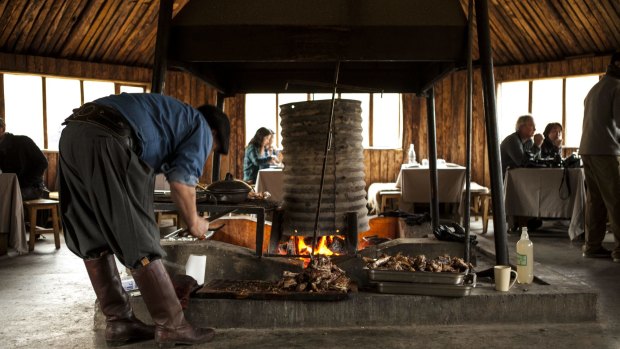
The toasty barbecue area at the Explora Lodge.
In fact, we are citizen conservationists: whatever we see will be shared with the local Awasi Foundation, which studies, tracks and aims to protect Patagonia's pumas. Cristian Asun, its excursions manager, says there's an estimated 100 pumas in the park, rising to 200 when you include those roaming the neighbouring estancias, or ranches. Therein lies the problem: the largest of this mountain lion species, Patagonian pumas can reach 2.8 metres in length and a slow-footed sheep or calf is an easier catch than a fleet, 90 kilogram guanaco, a cousin to the llama.
The Chilean government hauled a protective cloak over its pumas in the 1970s, but they've been hunted to near threatened status and it is us, as we protect our food source, who are the culprits. Furthermore, it's taken the BBC 30 years or so to film these elusive creatures hunting: little wonder they're billed as "ghost cats".
Back on the puma trail, long-legged jackrabbits, a favourite puma snack, erupt from the dark edges of the roadside, while guanaco herds, once pushed out by sheep and cattle estancias, leave mounds of brilliant green grass in their wake. "Guanaco toilet," says Rodrigo explaining their communal bathroom habits. The canny creatures are civic-minded, as well. During a trek over hills (that have been cloaked in the residual fug of an upset skunk) to see cave paintings by the Aonikenk people, we hear a guanaco whinnying an alarm call – a cross between a bark and neigh – and we're on high alert. This is a key puma signal. Soon after, a large guanaco trots purposefully down our path, passing within a metre of us before disappearing over a ridge.
The omens are good, and standing atop the ridge, we strain our ears our eyes for pumas. The solitary hunters tend to attack uphill, so we wait, searching the skies for condors, eagles or caracas, who circle over kills. Meanwhile the temperature drops, setting muddy puddles to ice. "This is Patagonia," says Rodrigo. "The cold, the snow, the winter." But alas, no pumas.
BIG CAT ALERT
This morning brings a different view of the Paine massif, with a boat voyage to the glaciers at the foot of the mountains. From the decks of Lago III, we spy the three faces of the Grey Glacier. "That's too many faces," says Rodrigo, whose been doing this cruise for years.
The boat runs three times a day in summer, dropping down to just two sailings a week in winter, on a three-hour cruise. The Grey Glacier has receded so dramatically, hikers along the W route now need to detour to see its 25-metre high walls of blue ice.
Listed as a UNESCO world heritage site in 1979, the glacier stands 45 metres above sea level in Grey Lake. Sediment from the ancient icefield gives the lake its name and its colour, murky against the fresh, powder-blue glacier and icebergs that float by like defeated battleships.
Ten years ago, I was at this same glacier. Then, we pulled our boat up to the ice and chipped chunks of thousand-year-old ice to toss into our glasses of scotch. But not this time, for our pisco sours, tinged purple by the local calafate berry. The glacier is rapidly retreating into the Southern Patagonia Ice Field, the world's largest glacier out of the polar regions, and the third largest reserve of fresh water on the planet. A few years ago, says Rodrigo, the lakes froze for up to three months in winter. Now their frozen state lasts just a few weeks before the February floods of snowmelt.
Condors play over the peaks of the Paine Grande, whose icy needles pierce the cloud that cloaks its glory. The glaciers on their peaks carve the mountains, sculpting their faces into new horns. It will be impossible to spot pumas here. "You need at least three days to see a puma," says Rodrigo.We're on day three, and we're developing the twitch of the frustrated hunter. I send my prayer up to the icy towers above, my wish carried on the steam of exhaled breath: "Just one puma. Just one puma."
Then we meet the Dutch cat tragics. Janco and Lennart are cat hunters who spend their holidays tracking felines all over the world, from the palace cats of Beijing to snow leopards in Ladakh. Janco shows us some magnificent photos then watches as our collective jaw drops as he tells us how, yesterday, he walked alongside a young puma on the edge of the road. The video is incredible. Even Rodrigo is impressed. If Janco wasn't so humble about his astonishing luck, I could have turned nasty.
Inspired, we head out for one more drive this evening, as pumas usually hunt at dawn and dusk. A half-moon is reflected in the section of the lakes that are not ice glazed, and the mood in the jeep is tense. We are on high alert with every rock surely a puma.
CARCASS CLUE
There's a golden triangle to the east of the national park, past the haunt of the black-headed swans, beyond the lake where the pink flamingos hang. Here, guanaco herds roam in their hundreds, guarded by their watchful outriders. Ever alert for danger, we spy their tensed profiles on the ridges. The hills are alive with three-course meals.
Surely, here be pumas? Rodrigo tells how he found the carcass of a shot puma last week. Killing pumas was outlawed in 1972 and while the estancias see a new source of income in allowing puma-spotting on their land, South America's most elusive big cats are still a threat to the cattle that graze on the fringe of the national park.
We do know that pumas eat part of the prey then hide it, returning for the next two or three nights for midnight feasts before abandoning the carcass to the condors, the caracaras, the eagles, the grey foxes and even the hairy Patagonian armadillos to snuffle over. So carcass spotting becomes our second concern.
The whole national park is a guanaco graveyard, with bones scattered along the roadsides, preserved by the frost and chill air. Some have been there for years, forming unofficial landmarks for the guides, and the region is famous for the discovery of a 10,000-year-old sloth, perfectly preserved. People get lost here and aren't found until next summer. "And though I walk through the valley of death…" I mutter, as we edge slowly through the frosted countryside.
Then he sees her. The twitch of a tail gives her away. Slowly, our eyes adjust to see two dove-grey cubs and their copper-coloured mama emerge into the winter sunlight, on the edge of Lago Sarmiento. The youngsters are joyous, one cub pouncing on his sibling, the two rolling like kittens – albeit huge, muscular kittens – before racing each other along the lake's shore.
They know we are here, but we are far away. Relaxed, the mother basks in the sun and we watch her cavorting cubs for about 40 minutes, until the clouds roll over the sun and sends them on their way. And then it snows: fresh show falling soft and powdery, silencing the landscape, throwing a white veil over the mountains. It's only 10.40am, we have three puma sightings under our belt and, with snowflakes on our tongues, we're elated.
HORSEBACK THRILL
This is Micho. In the warm kitchens of Explora Lodge's stables, the baqueano, or Chilean gaucho, sips his mate and teaches tricks to Tripa, the stables' marmalade cat. On horseback, however, he dominates: a spectacular force who controls the riders heading into the Torrres del Paine national park, knife wedged into his studded leather waistband, into which he's carved his name.
Raw and fierce, snow-laden winds dash at the wooden stable, while the horses stamp and blow. "These horses are so pampered, they wear pyjamas to bed," shouts Explora guide Alejandro over the wind. "They're given vitamins in winter to stop colds, they eat the finest food and then take the occasional visitor out for a trot."
As a result, they're as fresh as spring lambs, and ready to run. Micho, Alejandro and Rodrigo are all spectacular horsemen, while I feel like a (frozen) sack of coal. The wind tears across the landscape, chivvying snow flurries which it flings in our faces. My cheeks sting, my nose runs, my knuckles glow bright red with cold, the result of my forgotten gloves. Gallant Alejandro gives me one of his, and we tuck our single bare hands into the waistband of our trousers, close to our skin.
There's a flash of movement in front of us and we see her: our fourth puma today. Two more flashes, two more cubs. The three cats are lean and living in a grove near the Explora stables, gauchos report having seen up to six in this family.
Micho waves us back: the horses are edgy and my black-hearted beast has already once careened off on his own, and is dancing like a demon. We huddle together and simply watch the little band of hunters watching us while the baqueano takes my camera and, with his knees, urges his horse closer to the pumas while his hands click the camera.
Finally, the trio slinks back into the trees, and our ride back is exhilarating: even eagle-eyed Rodrigo, who has broken his own puma-spotting record of four in a day, is whooping along with the rest of us, as we push through the snow back to the warm kitchen, the mate and the cat.
That night, we go wild with the snow under our boots and the wind in our ears. We drink too much and tell stories of wild adventures and unfettered emotions, the log fire crackling in agreement. The Chilean wine is poured, the cheese is eaten, and we vow to return – in autumn, for a new season of discovery.
FIVE OTHER CITIZEN CONSERVATION PROGRAMS
FUR SEALS, AUSTRALIA
Log sightings of Australian fur seals that live in the Bass Strait between the mainland and Tasmania, and monitor the marine ecosystems around Phillip Island off the Victorian coast. See natureparksresearch.com.au
TURTLES AND BEARS, COSTA RICA AND SWEDEN
From saving turtle nests in Costa Rica to reducing human-bear conflict with brown bears in Sweden, these conservation tours track some of the world's most endangered species. See biosphereexpeditions.org
KOALAS, AUSTRALIA
Echidna Walkabout tours, from the Top End to Mungo National Park, focus on protecting and preserving the habitat of Victoria's wild koalas through tours and volunteer days. See echidnawalkabout.com.au
ORANG-UTANS, MALAYSIA
Professor Leif Cox founded The Orang-utan Project in 1998 and conducts educational tours in Indonesia and Malaysia to help the survival of orang-utans and the protection of their habitat through tourism. See orangutan.org.au
SPOTTED QUOLLS, AUSTRALIA
The new spotted quoll tracking project in Queensland's Atherton Tableland sees FNQ Nature Tours team up with the Australian Quoll Conservancy. See fnqnaturetours.com.au
FIVE TIPS FOR SUCCESSFUL PUMA SPOTTING
Wear colours that blend into the environment such as grey, brown or beige – no red – and don't wear perfume, but deodorant is OK.
Don't trespass. Private estancias, or ranches, surround the national park, and you need a permit to enter.
Look for puma poo and fresh guanaco carcasses, and listen for guanaco distress calls.
Be patient – pumas are becoming more used to humans, but they're still famously elusive. Like all wildlife activities, you may see one, or you may just have a lovely day walking in the mountains.
Pumas are most active at dawn and sunset so you have a better chance of sighting them at these times. If you do see one, keep your distance or stay inside your vehicle to avoid scaring them off.
FIVE MORE MUST-VISIT SPOTS IN SOUTHERN CHILE
ISLA MAGDALENA
This tiny island in the Strait of Magellan, is home to about 120,000 Magellanic penguins. Frequent tours make the two-hour boat journey from Punta Arenas.
PUNTA ARENAS' GRAVEYARD
Punta Arenas' melancholy, historic cemetery is a rival to Buenos Aires' La Recolata, with legendary love stories and wild characters from its racy gold rush years at the turn of the 19th century.
PIER AT PUERTO NATALES
This semi-submerged pier on the waterfront at Puerto Natales, the closest town to the Torres del Paine National Park, makes a great photograph and is best viewed from the deck of Kau cafe and lodge, opposite.
PUNTA ARENAS CORMORANTS
Punta Arenas sits at the confluence of the Pacific and Atlantic Oceans. Walk the waterfront to spot cormorants in their hundreds – the penguin-lookalikes perch on the piers. Turn 360 degrees to see a waterfront lined with murals.
NAO VICTORIA MUSEUM
At this museum in Punta Arenas you can see a full-size replica of Ferdinand Magellan's Nao Victoria, the first ship to circumnavigate the world. It sits on the docks alongside a replica of Ernest Shackleton's James Caird.
LATAM flies from Sydney and Melbourne to Santiago, with connections to Puenta Arenas and Puerto Natales, which are four hours and 1½ hours respectively by road from Torres del Paine National Park. See latam.com
STAY
Rooms at the five-star Explora Lodge have views to the Torres massif. Stays are all-inclusive of activities and meals. The four-star Hotel Lago Grey sits to the west of the Torres massif. See explora.com; lagogrey.com
TOUR
Quasar Expeditions runs five-day Secret Season itineraries from $4300 a person. Puma-tracking itineraries cost from $5540, including a tracking fee and four- or five-star accommodation. See quasarex.com
SPOT
Quasar Expeditions reports all sightings to the Awasi Foundation which studies, tracks and protects the Patagonian puma. All data is shared with the government entity that controls the national park and the pumas that roam its borders. See awasipatagonia.com
SECURITY
At the time of publication, Chile is subject to civil unrest with a state of emergency declared in most of the nation's major cities.The Australian Government recommends visitors exercise a high degree of caution. See smartraveller.gov.au
Belinda Jackson was a guest of Quasar Expeditions and LATAM Airlines.
Sign up for the Traveller Deals newsletter
Get exclusive travel deals delivered straight to your inbox. Sign up now.